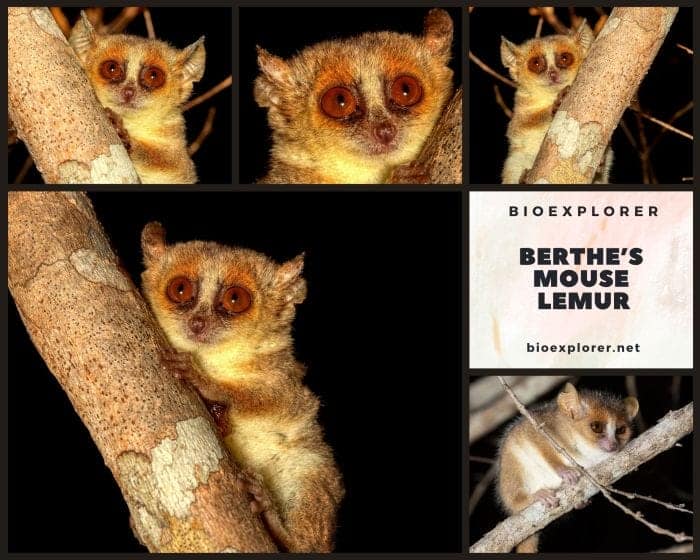
| Animalia | Primates | Cheirogaleidae | Microcebus | Microcebus berthae |
Madagascar is home to scores of unique wildlife species found nowhere else on Earth. But few are as endangered or obscure as Berthe’s mouse lemur (Microcebus berthae), the smallest known primate in the world.
Weighing only 1.1 ounces on average, this tiny nocturnal creature (also known as Madame Berthe’s Mouse Lemur) could easily fit in the palm of your hand. Endemic to a small region of deciduous dry forest in western Madagascar, Berthe’s mouse lemur narrowly avoided extinction soon after its discovery in the 1990s.
Today, rampant deforestation has destroyed much of its habitat. Estimates indicate over 50% of the Menabe forest region has disappeared over recent decades. This loss of the secluded, dense tangles of vines and trees Berthe’s mouse lemur depends on threatens to wipe out the remaining populations clinging to survival.
Yet there is still hope for saving this critically endangered species from vanishing completely. By spreading awareness and supporting conservation efforts, we can preserve Madagascar’s forests and their inhabitants for generations to come.
Table of Contents
- Berthe’s Mouse Lemur Distribution
- What Is Berthe’s Mouse Lemur?
- Berthe’s Mouse Lemur Characteristics
- Rampant Deforestation Driving This Species Towards Extinction
- Conservation Reliant on Recent Habitat Safeguards
- What Do Berthe’s Mouse Lemurs Eat?
- What Eats Berthe’s Mouse Lemurs?
- Surprising Facts About This Elusive Miniature Primate
- Spreading Awareness and Protection Vital for Its Future
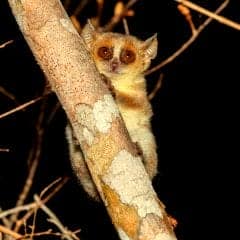

- Common Name: Berthe’s Mouse Lemur
- Taxonomy Classification Year: 2000
- Monkey Size: 9 to 11 cm (3.54 to 4.33 inches)
- Skin Color(s): Reddish-brown
- Habitat: Dry forest
- Diet: Omnivorous
- Native Countries: Madagascar
Berthe’s Mouse Lemur Distribution
What Is Berthe’s Mouse Lemur?
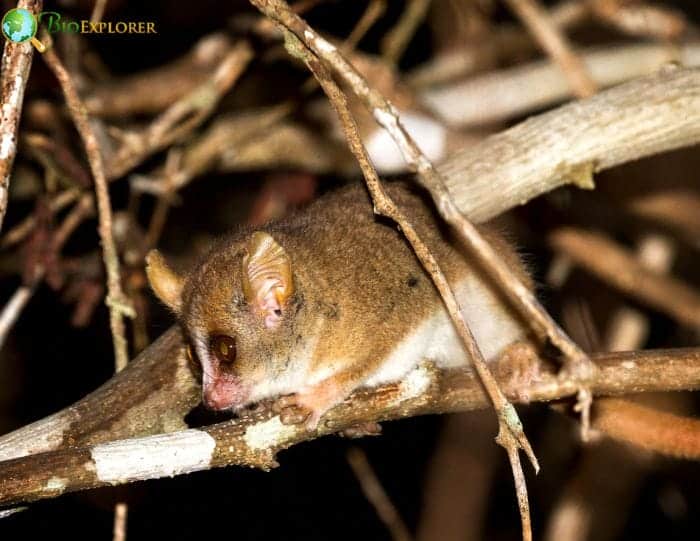
Berthe’s mouse lemur might be the world’s smallest primate, but there is more to this nocturnal forest-dweller than its diminutive stature.
- At just over 9 cm long from head to tail, Berthe’s mouse lemur weighs barely 30 grams on average. Its dense fur features cinnamon, ochre, and tawny tones blending across the back and limbs. Large eyes with a narrow black stripe across them help Berthe’s mouse lemur see at night to hunt insects and fruit.
- Microcebus berthae, the scientific name honoring French primatologist Berthe Rakotosamimanana, belongs to the mouse lemur genus containing over 20 known miniature primate species.
- All are native to Madagascar, where they diverged into a dazzling array of secretive nocturnal hunter-gatherers occupying specialized forest niches across the island.
- True to its common name, Berthe’s mouse lemur resembles a tiny mouse with grasping hands and a long tail for balance when leaping through the trees. But its round head and large eyes reveal its primate origins.
Mouse Lemurs, including Berthe’s, possess the long limbs, quick reflexes, and superb night vision typical of many prosimian primates.
![]()
Berthe’s Mouse Lemur Characteristics
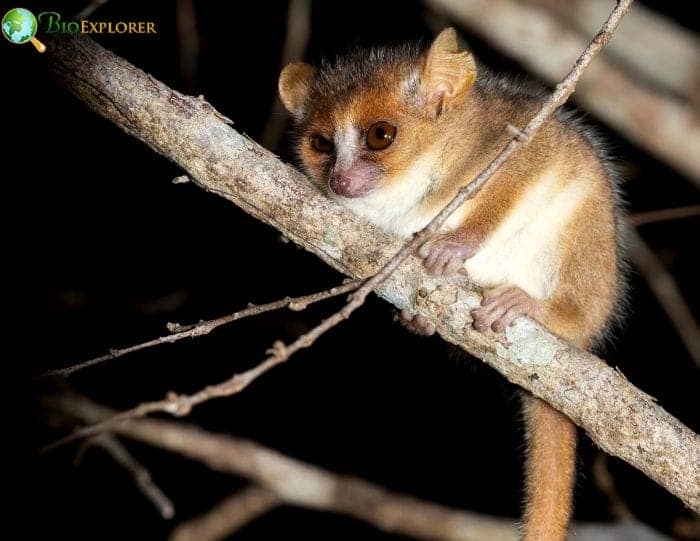
In addition to its petite stature, Berthe’s mouse lemur possesses several other distinctive physical features.
- Dense fur made up of multiple layers helps retain heat during Madagascar’s arid winters. Its coloration features a tawny brown mantle across the back and head complemented by a pale gray underside and yellowish limbs.
- Intricate earthen hues provide remarkably effective nocturnal camouflage once inside the tangle of vines and branches comprising its forest habitat.
- Keen vision further aids its survival, with oversized dark eyes dominated by lightly colored rings surrounding the pupils. These gather scarce moonlight and starlight during short activity periods spent hunting insects and fruit.
- Meanwhile, shape-shifting bat-like ears endowed with impressive muscles for aiming to enhance directional hearing are useful for avoiding larger predators.
- Limber limbs allow Berthe’s mouse lemur to traverse headfirst along narrow supports. It can launch daring leaps across substantial gaps to evade predators.
- A long tail counterbalances these daring aerial maneuvers and serves as a cozy blanket when curled up to sleep inside self-made nests hollowed from rotted logs or tree hollows.
- Hind feet with prominent toe tufts provide further insulation alongside added traction when moving through the canopy at full tilt.
![]()
Rampant Deforestation Driving This Species Towards Extinction
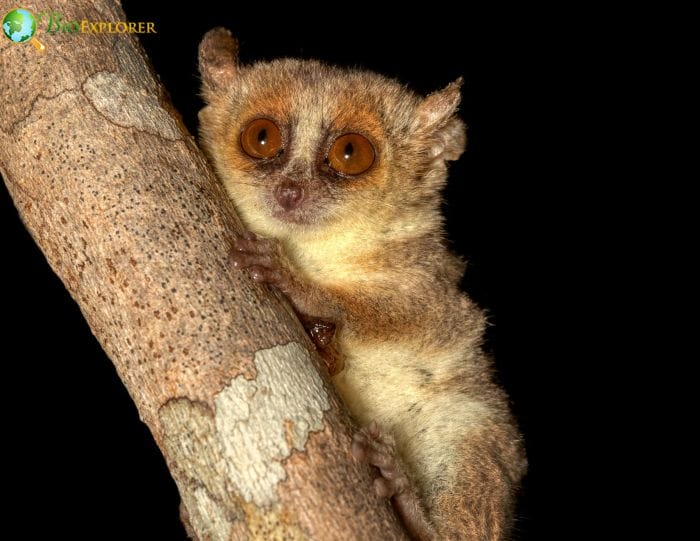
The greatest threat pushing Berthe’s mouse lemur precariously close to extinction is the rapid destruction of its forest habitat.
- Decades of widespread slash-and-burn agriculture, illegal logging, and charcoal production have ravaged western Madagascar’s deciduous dry forests.
- Berthe’s mouse lemur is endemic to the Menabe region’s Kirindy forest, part of a vanishingly small 22, 000-hectare strip of woodland left unscathed. However, weak enforcement of protected areas persists, with land being cleared for tavy farming plots on a destructive rotational cycle.
- Between 1985 and 2000 alone, over 50% of the Menabe forest area disappeared. At this rate, herpetologist and conservationist Frank Glaw estimates Berthe’s mouse lemur may be extinct in the wild within 10 years.
- Already extirpated from several forests where it once roamed, only an estimated 7, 920 individuals remained as of 2000.
Compounding habitat pressures, Berthe’s mouse lemur also suffers 70% mortality to predators like the fossa and henst’s goshawk. Losing more forest cover leaves it dangerously exposed. Preserving the integrity of protected parks like Kirindy is now the only hope for sustaining viable breeding populations.
![]()
Conservation Reliant on Recent Habitat Safeguards
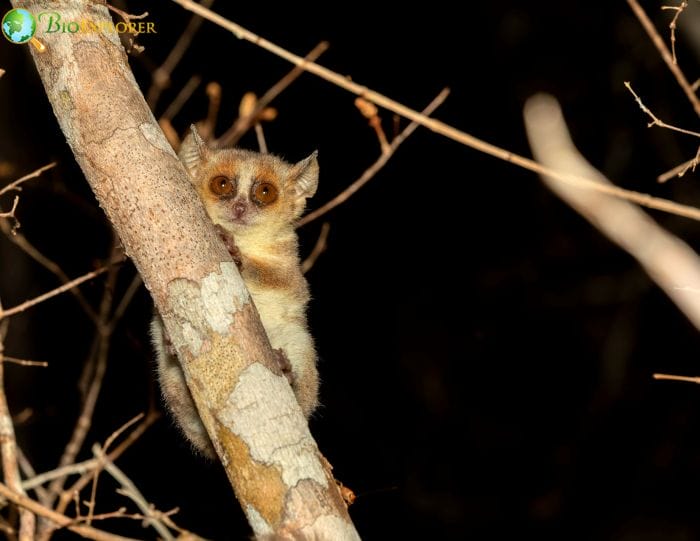
Classified as a critically endangered species by the IUCN Red List since 2012, the outlook remains dire for Berthe’s mouse lemur without rapid intervention. Its confined range held little state protection until the recent Menabe-Antimena Protected Area designation.
- This conservation corridor encompasses the Kirindy forest and surrounding woodlands vital to Berthe’s mouse lemur’s survival. But chronic budget shortfalls undermine enforcement needed to end illegal clearing and logging so parks remain only “paper protected”. No population monitoring programs or captive breeding efforts are underway either.
- Local communities receive support through wildlife farming and sustainable agriculture initiatives to curb further tavy dependence. Yet these have achieved only limited success as political instability hampers lasting progress.
- Consequently, the fate of the world’s smallest primate hinges wholly on maintaining sufficient viable habitat until conservation capacity strengthens.
Even small donations to on-the-ground lemur monitoring and reforestation programs sponsored by Frankfurt Zoological Society’s Projet Titi field team provide a tangible impact.
![]()
What Do Berthe’s Mouse Lemurs Eat?
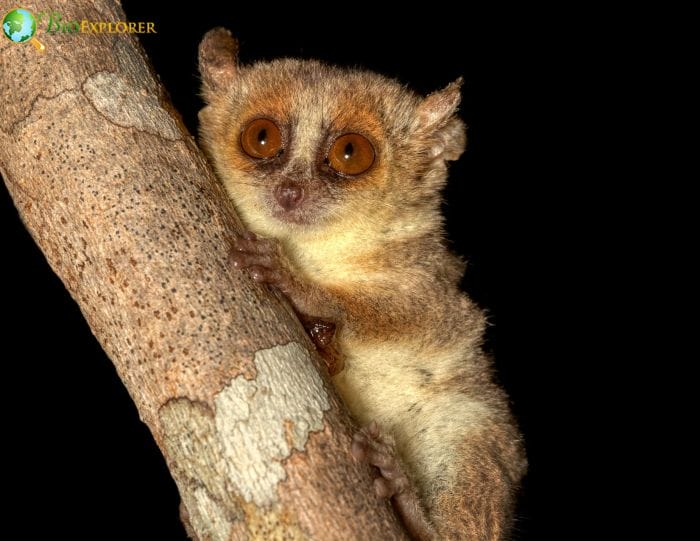
Despite weighing little more than a small tangerine, sustaining such an elevated metabolism demands Berthe’s mouse lemurs adopt an opportunistic approach to finding food. Their survival hinges on exploiting seasonal plenty whenever available.
- During Madagascar’s humid summers, fruit and insect secretions dominate their nourishment.
- Fig concentrate offers a particular favorite, with its high sugar content efficiently powering nightly escapades.
- Once ripe local fruits grow scarce amid the dry forests of winter and spring, arthropods and even small vertebrates supplement flagging energy reserves.
- Chameleons, leaf-tailed geckos, and other rainforest reptiles may all fall prey to Berthe’s mouse lemur should they make the fatal mistake of venturing out at night within reach.
- Even smaller lemurs and rodents risk becoming a meal for this diminutive predator when pickings slim down.
No part of potential sustenance goes ignored – Berthe’s mouse lemur thinks nothing of stripping bark for the tasty morsels found underneath or supplementing protein with opportunistic raids on nests containing eggs or hatchlings of birds, bats, and other mammals.
Overall, a generalist able to capitalize on seasonal and localized resource booms, only madreporic honeydew secretions from sap-sucking insects offer a constant lifeline during lean periods to sustain Berthe’s remarkable day-to-day energy expenditure.
![]()
What Eats Berthe’s Mouse Lemurs?
Weighing barely an ounce, Berthe’s mouse lemurs occupy the lowest rungs of the food chain. A wide array of Madagascar’s carnivores and raptors target adults and vulnerable juveniles as easy meals.
- Forest-dwelling fossa view the small primates as routine prey when encountered, swiping them from branches or ambushing them on the ground.
- These nimble, cat-like predators boast extra-stretchy ankles, allowing them to rotate their hind feet nearly 180 degrees perfect for descending headfirst down trees in pursuit of panicked lemurs.
- Quick enough to snatch a mouse lemur mid-leap between trees, Henst’s goshawks supplement their diets thanks to superior vision, pinpointing any unlucky lemur exposed while foraging at night. Female hawks are particularly prone to targeting mouse lemurs to feed their nestlings.
- Owls are adept at navigating dense forests under nighttime conditions, too. Madagascar owl and marsh owl species find rich hunting once the sun disappears below the horizon, with mouse lemurs offering tender mouthfuls.
- While mainly chasing small rodents, the quickness, and agility of domestic cats and dogs gone feral also enable them to catch Berthe’s mouse lemurs.
- During the brief daytime periods when Berthe’s mouse lemurs huddle in sleeping nests, threats continue from aerial predators like Madagascar buzzards, capable of spotting the well-camouflaged primates once alerted by cues like scent markings or sounds.
![]()
Surprising Facts About This Elusive Miniature Primate
For all the grave uncertainty Berthe’s mouse lemur faces, much about the species’ ecology and adaptability remains shrouded in mystery. What little research exists reveals some fascinating insights.
- Berthe’s mouse lemur and the similar gray mouse lemur (M. murinus) have nearly indistinguishable diets dominated by insects and fruit. Yet they spatially and temporally avoid competing with one another.
- Unlike some lemurs, Berthe’s mouse lemur does not hibernate but maintains year-round activity even when resources turn scarce.
- Females occupy overlapping home ranges around 2 hectares in size, while males traverse larger 5 hectares ranges encompassing multiple females’ territories.
- Depending on the region and season, population density fluctuates from less than 1 to over 15 Berthe’s mouse lemurs per square kilometer.
- The antenna-like tufted ears can pivot independently to precisely locate noises, helping Berthe’s mouse lemur evade predators and hunt small prey in the dark.
- Weighing only 30 grams, Berthe’s mouse lemur is less than half the size of the already tiny gray mouse lemur.
- Beyond insects and fruit, Berthe’s mouse lemur supplements its diet by occasionally hunting small vertebrates like chameleons and geckos.
- Unlike the solitary gray mouse lemur, Berthe’s mouse lemur will sleep huddled together with others for warmth during the colder dry season.
- Though arboreal, mouse lemurs descend to the ground more than any other, with Berthe’s mouse lemur spending up to 20% of its nightly activity on the forest floor.
- Discovered in 1992, Berthe’s mouse lemur remained little studied for decades and is still absent from any captive breeding programs or population monitoring.
![]()
Spreading Awareness and Protection Vital for Its Future
Now believed extinct across much of its former range, as few as 8,000 Berthe’s mouse lemurs cling to survival in a shrinking habitat niche. Allocating more resources to defend Madagascar’s protected parks and reserves offers some hope if acted upon urgently.
- Halting the present pace of habitat loss would buy time to enact lasting policies. Community-based reforestation initiatives also brighten the outlook for regaining lost forest complexity over generations. With luck and commitment, ecotourism may one day support local livelihoods enough to lift reliance on wildlife-harming practices.
- But such optimism remains premature when confronted by the ongoing crisis facing Berthe’s mouse lemur and most endemic wildlife across Madagascar’s decimated landscapes. Only spreading awareness and increasing scientific study of this overlooked species provides insurance should dedicated reserves collapse to unrelenting human pressures in the decades ahead.
- After rediscovering such an astounding and perplexing natural wonder over 30 years ago, losing the world’s smallest primate would be profoundly tragic without having fully documented what made its evolution possible. There may be time to uncover these secrets and insights from nature’s imagination and generosity by allowing wilderness to endure.
![]()











